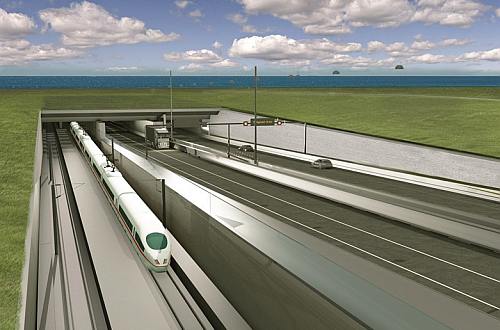The 18km tunnel will run from Puttgarden on the island of Fehmarn to Rødby on the Danish island of Lolland, carrying a four lane road, a double-track electrified railway line and a maintenance and evacuation corridor. The tunnel will be up to 47m-wide and 13m-high, and will be built using prefabricated sections that will be sunk into a channel dug into the sea bed.
Six lawsuits were brought against the project by two environmental associations, three companies - including Scandlines, the operator of the existing Puttgarden - Rødby ferry line - and the city of Fehmarn. Lawsuits from three other municipalities and a farmer were terminated amicably.
The court ruled that the project does not lack planning justification, with the traffic needs for the fixed link established by law. This would only be removed if there was a fundamental change in the traffic needs for the tunnel, which the court found does not exist. The European Commission considers the Fehmarn Belt link one of the five most important cross-border projects of the Trans-European Transport Network (TEN-T), with the shorter Hamburg - Copenhagen journey times expected to lead to a shift from traffic travelling over the Great Belt via Zealand.
The court found that the financial feasibility of the project was also legal, with the Danish state aid envisaged in favour of the operating company not manifestly contrary to European law.
Another challenger alleged that the project would violate conservation law, but the court ruled this was not the case.
Environmental measures that will be implemented during construction include establishing a precautionary noise limit to protect harbour porpoises living in the Fehmarn Belt from construction noise, which is significantly lower than the level of noise from large ships and ferries. Bubble curtains will also be used to reduce the noise from underwater blasting by up to 90%. The court says that in-depth studies have shown that the project does not pose a significant risk of disturbing or killing resting birds, in particular eider ducks that spend the winter in the Fehmarnbelt.
In response to concern about reefs surrounding Fehmarn, the court found the project planning took sufficient care to protect the biotopes in the area.
While a scientific research project undertaken by the University of Kiel did not identify reefs in the immediate vicinity of the tunnel route until after the planning approval decision was issued, the court found this does makes the planning approval decision lawful. As a result, the project will have to wait on a decision on whether it will be exempt from these restrictions before beginning work in the area due to a statutory prohibition on destroying or damaging biotopes.
In addition, the court found the cut and cover tunnel method was more suitable than using tunnel boring machines (TBM), which would have had less of an impact on the environment. As well as resulting in costs increasing by a third, tunnel boring would have also caused in unacceptable risks due to the required diameter of the TBMs, the length of the bored section and the high water pressure.
According to the 2009 German-Danish State Treaty, Denmark will construct and operate the fixed link across the Fehmarn Belt at its own expense. Two public undertakings have been entrusted with the planning, construction and operation of the project: Femern Landanlæg for the Danish hinterland connections and Femern for the coast-to-coast infrastructure. Costs will be recovered through tolls and rail usage fees.
For detailed data on rail projects around the world, subscribe to IRJ Pro.

